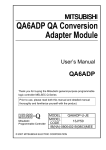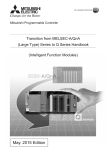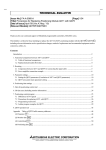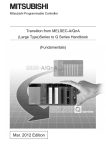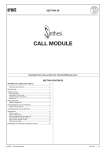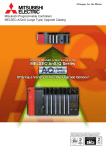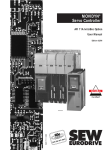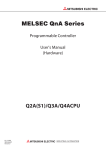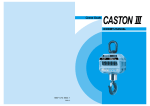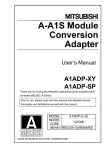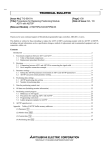Download QA65B/QA68B Extension Base Unit User`s Manual
Transcript
QA65B/QA68B
Extension Base Unit
User’s Manual
Thank you for buying the Mitsubishi general-purpose programmable
controller MELSEC-Q Series
Prior to use, please read both this manual and detailed manual
thoroughly and familiarize yourself with the product.
MODEL
QA65B-U-E
MODEL
13JR26
CODE
IB(NA)-0800158-D(1004)MEE
©2000 MITSUBISHI ELECTRIC CORPORATION
z CONDITIONS OF USE FOR THE PRODUCT z
(1) Mitsubishi programmable controller ("the PRODUCT") shall be used in
conditions;
i) where any problem, fault or failure occurring in the PRODUCT, if any, shall
not lead to any major or serious accident; and
ii) where the backup and fail-safe function are systematically or automatically
provided outside of the PRODUCT for the case of any problem, fault or
failure occurring in the PRODUCT.
(2) The PRODUCT has been designed and manufactured for the purpose of
being used in general industries.
MITSUBISHI SHALL HAVE NO RESPONSIBILITY OR LIABILITY
(INCLUDING, BUT NOT LIMITED TO ANY AND ALL RESPONSIBILITY OR
LIABILITY BASED ON CONTRACT, WARRANTY, TORT, PRODUCT
LIABILITY) FOR ANY INJURY OR DEATH TO PERSONS OR LOSS OR
DAMAGE TO PROPERTY CAUSED BY the PRODUCT THAT ARE
OPERATED OR USED IN APPLICATION NOT INTENDED OR EXCLUDED
BY INSTRUCTIONS, PRECAUTIONS, OR WARNING CONTAINED IN
MITSUBISHI'S USER, INSTRUCTION AND/OR SAFETY MANUALS,
TECHNICAL BULLETINS AND GUIDELINES FOR the PRODUCT.
("Prohibited Application")
Prohibited Applications include, but not limited to, the use of the PRODUCT
in;
y Nuclear Power Plants and any other power plants operated by Power
companies, and/or any other cases in which the public could be affected if
any problem or fault occurs in the PRODUCT.
y Railway companies or Public service purposes, and/or any other cases in
which establishment of a special quality assurance system is required by
the Purchaser or End User.
y Aircraft or Aerospace, Medical applications, Train equipment, transport
equipment such as Elevator and Escalator, Incineration and Fuel devices,
Vehicles, Manned transportation, Equipment for Recreation and
Amusement, and Safety devices, handling of Nuclear or Hazardous
Materials or Chemicals, Mining and Drilling, and/or other applications
where there is a significant risk of injury to the public or property.
Notwithstanding the above, restrictions Mitsubishi may in its sole discretion,
authorize use of the PRODUCT in one or more of the Prohibited Applications,
provided that the usage of the PRODUCT is limited only for the specific
applications agreed to by Mitsubishi and provided further that no special
quality assurance or fail-safe, redundant or other safety features which
exceed the general specifications of the PRODUCTs are required. For
details, please contact the Mitsubishi representative in your region.
1. Overview
1.1 Overview
This User's Manual describes the specifications, configuration devices, names and
settings of each part, and mounting and installation of the QA65B extension base unit,
QA68B extension base unit (hereinafter, QA6
B).
Refer to the QCPU User's Manual(Hardware Design, Maintenance and Inspection)
SH-080483ENG enclosed with the main base unit for the matters not described in this
manual, such as the QA6
B safety precautions and general specifications.
1.2 Supplied parts
The parts enclosed with this module are listed below.
Product
Type
Extension base unit
QA6
B
I/O number seal
This manual
-
Quantity
1
1
1
2. System Configuration
2.1 System configuration
The system configuration and precautions for using the QA6
B extension base unit are
described in this section.
(1) Extension base unit connection order
When using the Q5
B/Q6
B, QA1S6
B and QA6
B together, connect from the
unit closest to the main base unit in the order of Q5
B/Q6
B, QA1S6
B and
QA6
B.
(2) Setting order of the expansion stage numbers for expansion base units
Expansion base units require the setting of the expansion stage numbers (1 to 7)
using the stage setting connector.
Assign the expansion stage numbers starting from 1 to 7 to the expansion base
units counting from the one which is connected to the main base unit.
1
QCPU
Q38B
8 9 10 11 12 13 14 15
QCPU
Stage setting
connector
Power supply
Setting of
extension stage
Power supply
0 1 2 3 4 5 6 7
Q68B
QCPU
2
Power supply
16 17 18 19 20 21 22 23
QA1S68B
QCPU
3
Power supply
24 25 26 27 28 29 30 31
QA68B
Main base unit
Extension base unit for module
installation corresponding to the
Q series
(Connect the Q5 B/Q6 B with
the main base unit and the last
Q5 B/Q6 B.)
Extension base unit for module
installation corresponding to the
AnS series
(Connect the QA1S6 B with
the main base unit and the last
Q5 B/Q6 B, or QA1S6 B.)
Extension base unit for module
installation corresponding to the
A series
(Connect the QA6 B with the
main base unit and the last Q5 B
/Q6 B/QA1S6 B, or QA6 B.)
2.2 List of configuration devices
The following shows the applicable types for configurations of the QA6
B.
Module
Type
Remarks
Power module
A61P,
A68P,
A61PN,
A61PEU,
A62P,
A62PEU
A63P,
Input module
AX10,
AX21,
AX40,
AX42-S1,
AX71,
AX81-S1,
AX82
AX11,
AX21EU,
AX41,
AX50-S1,
AX80,
AX81-S2,
AX11EU,
AX31,
AX41-S1,
AX60-S1,
AX80E,
AX81-S3,
AX20,
AX31-S1,
AX42,
AX70,
AX81,
AX81B,
Output module
AY10,
AY11E,
AY13E,
AY23,
AY42,
AY42-S4,
AY60,
AY71,
AY82EP
AY10A,
AY11AEU,
AY13EU,
AY40,
AY42-S1,
AY50,
AY60S,
AY72,
AY11,
AY11EEU,
AY15EU,
AY40A,
AY42-S2,
AY51,
AY60E,
AY80,
AY11A,
AY13,
AY22,
AY41,
AY42-S3,
AY51-S1,
AY70,
AY81,
I/O module
A42XY,
AH42
High-speed counter module
AD61,
AD61S1
Analog-digital conversion
module
A68AD,
A68AD-S2,
A68ADN,
A616AD
Digital-analog conversion
module
A62DA,
A616DAV,
A62DA-S1,
A616DAI
A68DAV,
A68DAI-S1,
Temperature-digital
conversion module
A68RD3,
A616TD,
A60MXT,
A68RD3N,
A60MX,
A60MXTN
A68RD4,
A60MXR,
A68RD4N,
A60MXRN,
Interrupt module
AI61,
AI61-S1
AD70,
AD71S2,
AD70D,
AD71S7,
AD75P1-S3,
AD75M1,
AD75P2-S3, AD75P3-S3,
AD75M2,
AD75M3
Positioning module
MELSECNET/MINI-S3
master module
AJ71PT32-S3, AJ71T32-S3
*1
*2
AD71,
AD72
AD71S1,
*1
*1
Module
Type
Intelligent communication
module
AD51,
AD51E-S3,
PC fault detection module
AS91
MELSEC-I/OLINK module
AJ51T64
B/NET module
AJ71B62-S3
Blanking module
AG60
Dummy module
AG62
AD51E,
AD51H-S3
AD51H,
Remarks
AD51-S3,
*2
A-A1S conversion adapter
A1ADP-XY,
A1ADP-SP
*3
*1: The dedicated commands used in the QnA and A Series program cannot be used with the Q mode
CPU.
Replace these with FROM/TO commands.
*2: There is a limit to the number of mountable modules.
Module
Type
Intelligent communication module AD51, AD51E, AD51-S3, AD51E-S3,
AD51H, AD51H-S3
Interrupt module
AI61, AI61-S1
number of mountable
6 *4
1 *5
*3: For units to be installed, refer to the A-A1S conversion adapter manual.
*4: In combined use of the QA1S6
B and QA6
B, up to 6 intelligent communication modules can be
installed.
*5: Only one interrupt module is valid which can be chosen from QI60, A1SI61, AI61 or AI61-S1.
3. Specifications
3.1 Specifications
The QA6
B performance specifications are given below.
Type
QA65B
QA68B
Item
Number of I/O modules connected
5
8
Applicable modules
A series module
5VDC internal current consumption (A)
0.117
0.117
Weight (kg)
1.60
2.00
4.Names and setting of parts
The names of and settings for each QA6
B part are explained in this section.
4.1 Names of parts
The names of each QA6
B part are explained below.
QA65B, QA68B
3)
5) 6)
4)
7)
1)
2)
QA68B
5) 6)
No.
1)
2)
3)
4)
5)
6)
7)
Name
Usage
A connector for signal transmission with the basic base
module or the other expansion base module. Connects the
Expansion cable
expansion cable. Do not remove the supplied connector
connector
cover.
Base cover
PCB surface protection cover.
Stage number
A used to set the stage numbers of the expansion base
setting connector modules. Refer to section 4.2 for the setting procedure.
Connector for mounting power supply unit, input/output unit
and special function module.
Module connector Mount the dustproof connector cover, blank cover unit
(AG60) or dummy unit (AG62) on the connector in the spare
spaces with module connected.
Module fixing hole Cut out to accept projection and hook at rear of modules.
Screw hole for
A screw hole used for fastening a module to the base.
fastening modules (M4 screw)
Base module
A hole used for mounting the base module to a panel such as
installation hole
a control panel.
4.2 Setting the expansion stage numbers
The method of setting the QA6
B stages is explained below.
Remove the base cover from the
expansion base module.
Select the stage number from 1 to
7 in the connector (PIN1) loaction
between the expansion cable
connectors IN and OUT. Then,
insert a connector pin into the
approprate stage number.
CON11 CON10
PIN1
Reattach the base cover to the
expansion base module and
fasten the screws.
(Tightening torque: 36 to 48N cm)
Completion
Stage number setting for expansion base modules
Stage number setting
1th
2th
3th
4th
5th
6th
stage
stage
stage
stage
stage
stage
Position of
connector pin in
stage number
setting connector
PIN1
PIN1
PIN1
PIN1
PIN1
PIN1
7th
stage
PIN1
Point
(1) To set the stage number setting connector, select the appropriate number from 1
through 7 in ascending order according to the number of expansion modules.
(2) Do not assign the same stage number to several modules or skip any stage
numbers. Otherwise, improper I/O operation results.
(3) The expansion stage number is factory-set to 1.
5. Loading and Installation
5.1 Module Installation
This section describes the precautions to handle the CPU, I/O, special function, power
supply, and base module.
(1) Do not drop or apply a strong impact to the module housing, memory card, terminal
block connectors, and pin connectors.
(2) Do not remove the PC board of the modules from housing. Otherwise, malfunctions
may result.
(3) When using the expansion base module QA6
B, be sure to install the power
supply module.
Although the module may work without the power supply module under light load,
stable operation is not guaranteed.
(4) Limit the tightening torque for the module installation screws and terminal block
screws within the following range:
Location of screw
Tightening torque range
I/O module terminal block installation screw (M3)
36 to 48Nycm
A series module installation screw (M4)
78 to 118Nycm
I/O module terminal screw (M4)
Power supply module terminal screw (M4)
98 to 137Nycm
(5) When using the expansion cable, do not bind it with or place it close to the main
circuit (high-voltage, large-current) lines.
5.2 Precautions for installing base unit
(1) Unit installation position
Indicates the panel top,wiring
duct, or any assembly.
Q3 B basic base
80mm(3.15in)
or more
QA6 B extention base
*1
Parallel mounting
Indicates the panel top,wiring
duct, or any assembly.
80mm(3.15in)
or more
Basic base
Extention base
Duct
(max. 50mm
(1.97 in))
*2
80mm(3.15in)
or more
*1
Serial mounting
*1:
When link module is not used
50mm or more
When using φ4.5mm optical fiber cable
100mm or more
When using a coaxial cable
130mm or more
When using φ8.5mm optical fiber cable
*2: 20mm or more when connecting extension cable without removing adjacent
modules.
(2) Module installing position
(a) Install the PC in the following position to ensure ventilation for heat radiation.
(b) Do not install the PC in the following positions.
Vertical position
Horizontal position
(3) Install the base module on a flat surface.
When the base module is installed on an uneven surface, the PC board may be
strained, resulting in malfunction.
(4) Do not install the PC close to a vibration source such as a large electromagnetic
contactor or no-fuse breaker. Install the PC to the separate panel or isolate it as far
as possible.
(5) Provide the following distances between the PC and devices (contactor or relay) to
avoid the influence of radiation noise or heat.
y Device installed in front of the PC: 100mm or more
y Device installed on either side of the PC: 50mm or more
50mm or more
100mm
or more
50mm or more
Contactor
relay,etc
5.3 Installation and removal of modules
This section explains the installation and removal procedures of the power supply
module, CPU module, I/O module, special function module, etc to and from the base unit.
(1) Installation of module
Module fixing hole(A)
Insert the two module fizing
projections (two) into the
module fixing hole (B) in the
base unit.
Load the module into the
base unit by pushing it in the
direction of arrow.
Check if the hook of module
is securely inserted in the
module fixing hole (A) in the
base unit.
Base unit
Hook
Module unit
Module
connector
Two module
fixing projections
Module fixing hole(B)
Complated
Base unit
Module
Module mounting screw
(M4(0.16) 0.7(0.03) 12(0.47))
Points
(1) To fix the module, be sure to insert the module fixing projection into the module
fixing hole (B). If the module is forcibly fixed without insertion, the pins in the module
connector may be bent or damaged.
(2) When the base unit is used at locations where there are especially large vibration
and/or shock, screw the module to the base.
(2) Removal of module
Base unit
Hold the module with both
hands and push the hook
latch at the top of module.
While pushing the hook
latch, pull the module toward
you.
Lift upwards and remove the
module fixing projections
from the module fixing hole
(B).
Module fixing hole(A)
Push
hook
Module
connector
Module
Moduke
fixing
hole (B)
Completed
Points
To remove the module, be sure to disengage the hook from the module fixing hole (A)
and then remove the module fixing projections from the module fixing hole (B). If the
module is forcibly removed, the hook or module fixing projections will be damaged.
Appendices
Appendices 1 External Dimension Diagram
The external dimensions of the QA6
B are shown below.
Hand
hold
QA68
4- 6 installation hols
(M5 mounting screw)
200 0.3
(7.87 0.01)
250 (9.84)
2 9-M4 screws
(for mosule installation)
Base cover
446 0.3 (17.56 0.01)
46.6
(1.83)
10
(0.39)
466 (18.35)
Unit: mm (in.)
The external dimensions of the QA68B
2 6-M4 screws
(for mosule installation)
Hand
hold
QA65B
4- 6 installation hols
(M5 mounting screw)
200 0.3
(7.87 0.01)
250 (9.84)
Base cover
332 0.3 (13.07 0.01)
46.6
(1.83)
10
(0.39)
352 (13.86)
Unit: mm (in.)
The external dimensions of the QA65B
Warranty
Mitsubishi will not be held liable for damage caused by factors found not to be the cause of
Mitsubishi; machine damage or lost profits caused by faults in the Mitsubishi products;
damage, secondary damage, accident compensation caused by special factors
unpredictable by Mitsubishi; damages to products other than Mitsubishi products; and to
other duties.


















